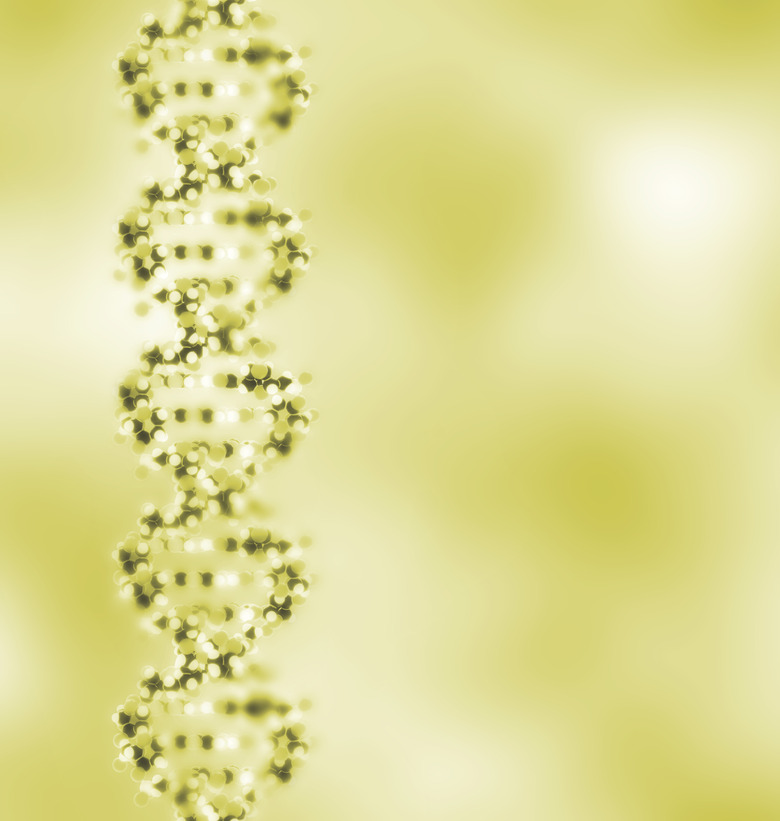Why Might A Cell Make Lots Of rRNA But Only One Copy Of DNA?
Each living cell contains DNA made of four building blocks called nucleotides. The sequence of nucleotides spells out genes that code for the proteins and RNA that cells require to grow and reproduce themselves. Each strand of DNA is maintained as a single copy per cell, while the genes found on a chromosome are often transcribed into many copies of RNA.
Three Main Types of RNA
Three Main Types of RNA
Cells need three main types of RNA to perform their biological functions: mRNA, tRNA, and rRNA. The type that serves as a template for making protein is mRNA, while tRNA and rRNA help with protein synthesis. The cellular machines that synthesize proteins are called ribosomes, and these are large complexes composed of several different rRNA molecules and more than 50 proteins. When an mRNA molecule combines with a ribosome, tRNA matches the mRNA template with the amino acids that make up a protein. The job of rRNA is to help with the chemical reaction of making bonds between amino acids.
Cells Contain Many Ribosomes
Cells Contain Many Ribosomes
A typical animal cell contains 8 to 10 billion protein molecules on average. Each protein must be synthesized on a ribosome, so clearly, a great number of ribosomes are required. A rapidly dividing cell may have up to 10 million ribosomes.
Ribosomes Contain rRNA
Ribosomes Contain rRNA
Ribosomes have two parts, called subunits, that come together around an mRNA molecule to synthesize a protein. The more than 50 proteins in a ribosome give the ribosome it's shape and structure. These proteins are organized around four large rRNA molecules, that also give the ribosome structure and help to catalyze the chemical reaction of joining two amino acids. Ribosomes are constructed in the nucleus of the cell, which is where DNA is located. Within the nucleus, rRNA is transcribed from DNA and processed into fragments that are incorporated along with protein to form ribosomes. The nearly-completed ribosomes are exported from the nucleus into the cytoplasm of the cell where their assembly is finished and they can then begin translating mRNA into protein.
Transcription of rRNA
Transcription of rRNA
So much rRNA is needed to make the up to 10 million ribosomes required by a cell that rRNA genes are repeated in tandem in a head-to-tail fashion on DNA. There are a total of about 100 copies of the main rRNA genes in the DNA of a typical animal cell. These tandemly repeated genes are needed to meet the great demand for ribosomes. But even with 100 copies of these genes, cells must still transcribe a great many copies of rRNA in order to produce the number of required ribosomes. This is why there are many copies of rRNA for every one copy of an rRNA gene per cell.
Cite This Article
MLA
Updegraff, Emily. "Why Might A Cell Make Lots Of rRNA But Only One Copy Of DNA?" sciencing.com, https://www.sciencing.com/might-cell-make-lots-rrna-but-only-one-copy-dna-10257/. 24 April 2017.
APA
Updegraff, Emily. (2017, April 24). Why Might A Cell Make Lots Of rRNA But Only One Copy Of DNA?. sciencing.com. Retrieved from https://www.sciencing.com/might-cell-make-lots-rrna-but-only-one-copy-dna-10257/
Chicago
Updegraff, Emily. Why Might A Cell Make Lots Of rRNA But Only One Copy Of DNA? last modified March 24, 2022. https://www.sciencing.com/might-cell-make-lots-rrna-but-only-one-copy-dna-10257/
